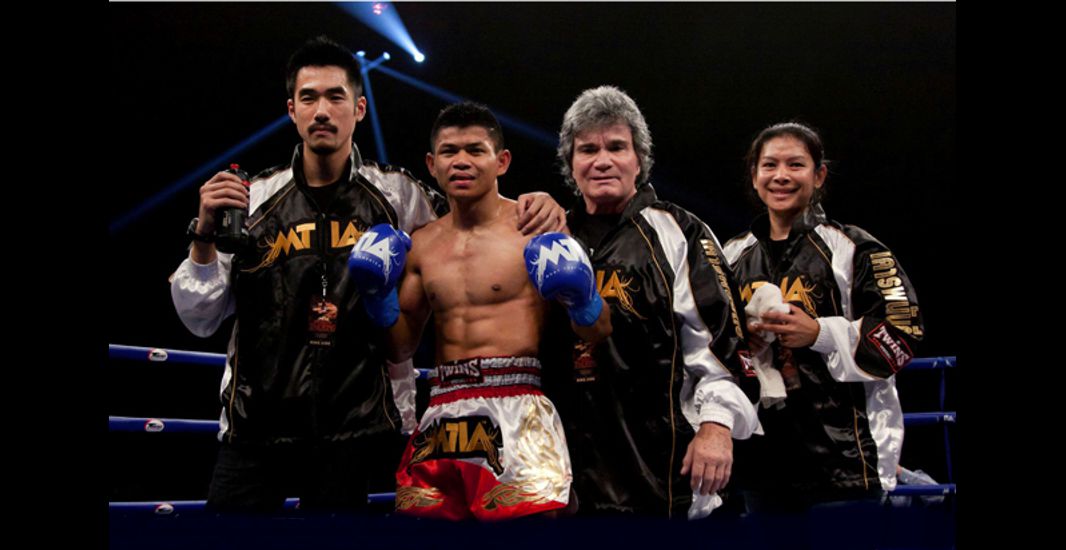Leg checks are a vital aspect of Muay Thai and no one knows that better than legendary instructor Bob Chaney. He consistently produces some of the best fighters in the world because he schools them to use all of their weapons efficiently, especially leg checks.
Leg checks are important for survival both defensively and offensively. Most fighters consider leg checking merely as defensive techniques but they can be utilized as awesome offensive techniques that can inflict tremendous pain and frequently cause debilitating injuries to your opponent as well.
To an inexperienced fighter leg checking is often nothing more than blocking one shin against another’s shin, thus becoming a flip-of-the-coin as to who gets the worse end of the impact or who can tolerate the most pain.
“It’s imperative to use proper body alignment, apply basic scientific principals and train repetitiously in order to form proper blocking techniques,” explained Chaney.
“Physics refer to the sweet spot or ideal area of the baseball bat, which contacts the ball, as the apex or point of curve”.
“To best illustrate the impact of a leg check, let’s say you have a ball bat and I have a ball bat. If I swing my bat at you, and you block it with the big part of your bat it would be okay. But if you block the apex (large part or sweet spot area) of my bat with the handle of your bat, mine would bust your bat in half.”
An example of the “big bat” principle happened when Gunn, (one of Chaney’s fighters,) was up against a superior leg kicker. Chaney instructed Gunn to attack his opponent by blocking with his knee to the opponents ankle/instep area using the science behind his baseball bat analogy. Gun won by way of a third round knock out when the fighter was unable to continue suffering a broken foot.
“Many fighters attempt to leg check by bringing their leg straight up resulting in a painful meeting of shins,” says Chaney. “This can be avoided with practice and applying physics and proper body alignment by positioning your body into the attack.”
“Another problem with raising your leg straight up to check is that when a fighter throws a leg kick coming from the outside in and you raise your leg straight up the force of his kick will turn your body leaving you vulnerable to follow up attacks. However, if you turn your knee out to meet his attack, by targeting your upper shin and knee towards his ankle/instep area, you will not lose your balance or your position.”
A well schooled fighter will also use leg checks to turn, or maneuver their opponent, thus setting him or her up for a series of counter attacks. Unfortunately learning how to leg check is often, but not necessarily, a painful process in trial and error. One of the most important and popular items is a pair of high quality professional shin guards. Proper conditioning of the shins is a part and parcel with learning how to execute leg checks.
“In the old days in Thailand fighters would kick banana trees to condition their shins,” said Chaney. “A banana tree isn’t like kicking an oak tree, it’s like a pineapple, and it’s pulpy. Today in Thailand they use banana bags, which is a canvas or vinyl covered six foot long bag that weighs between 120 and 160 pounds. Kicking the bag strengthens the muscles along the shin area and slowly deadens the nerves covering the shin. This kind of training is similar to how traditional Karate students punch a makiwara board to toughen and deaden the nerves of their knuckles.”
Chaney warns to use caution when practicing leg checks, even when wearing protective padding.
“Even with shin guards students need to refrain from using power until proper form and timing is learned,” said Chaney. “Students must practice slowly until thousands of repetitions finally allow the students to recognize and anticipate pending kicks.”
“What you learn in life isn’t important,” says Chaney. “What you remember is what’s important. So Remember! Practice doesn’t make perfect. Perfect practice makes perfect.” Chaney warns.











